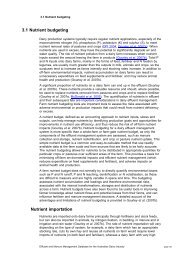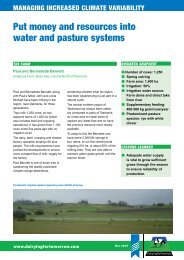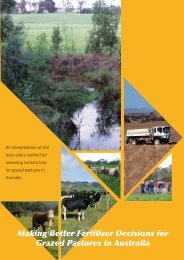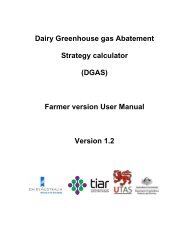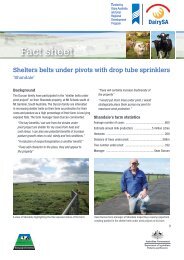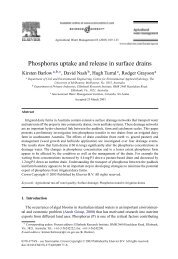Australian Dairy Industry In Focus 2009 - Dairying For Tomorrow
Australian Dairy Industry In Focus 2009 - Dairying For Tomorrow
Australian Dairy Industry In Focus 2009 - Dairying For Tomorrow
You also want an ePaper? Increase the reach of your titles
YUMPU automatically turns print PDFs into web optimized ePapers that Google loves.
Wholesale prices have held firm across the<br />
range of dairy products. Manufacturers<br />
have tended to prioritise the domestic<br />
market, given the downturn in export<br />
returns over the past 12 months. However,<br />
there will be some careful assessment<br />
of local returns in coming months, given<br />
the strengthening of world markets.<br />
Prices in the non-grocery (foodservice<br />
and industrial) sector have followed<br />
international commodity trends more<br />
closely than grocery prices as prevailing<br />
supermarket supply contracts have limited<br />
price adjustments.<br />
Expected increases in official interest rates<br />
may reduce discretionary spending locally.<br />
While this is unlikely to affect the volume<br />
of dairy products consumed, it may<br />
impact on the channel and value of dairy<br />
sales as consumers seek to “economise”.<br />
This would tend to favour increased<br />
sales of private label products through<br />
the supermarket channel, while branded<br />
products and foodservice sales are likely<br />
to be negatively affected.<br />
World supply<br />
Signs of slowing US production and<br />
the likelihood of lower supplies from<br />
the southern hemisphere, coupled with<br />
improving demand, are bringing the<br />
international dairy market back into<br />
balance. However, EU and US government<br />
intervention and stockpiles will continue<br />
to have a negative impact on market<br />
sentiment until they are removed.<br />
<strong>In</strong> Europe, farmers in the northern<br />
dairy belt are boosting supply in order<br />
to maintain income levels. However,<br />
new product entering intervention stores<br />
has almost come to a halt for both butter<br />
and SMP. The public butter stocks are<br />
equivalent to just 4% of annual EU butter<br />
production; but the SMP stockpile<br />
is more burdensome as it represents<br />
about 30% of annual EU SMP production.<br />
There is still no clear policy solution for<br />
eliminating the stockpile.<br />
US milk production has finally begun<br />
to fall slightly below last year, despite<br />
negative farm profitability for many<br />
months and is expected to fall further over<br />
the rest of the year. Encouragingly, sales<br />
of surplus milk powder to the government<br />
have slowed in recent months – with the<br />
stockpile at 25% of annual production –<br />
and no such sales are forecast for 2010.<br />
Argentina’s milk production is reportedly<br />
up 3-4% to August in <strong>2009</strong>. However,<br />
a slowing trend of recent months<br />
is expected to continue, with full year<br />
forecasts of 1% growth. Brazil’s milk<br />
production has continued to trail previous<br />
year levels all through <strong>2009</strong>; with<br />
production down 4-5% to July. A milder<br />
recession, coupled with a quick recovery,<br />
across the region will continue to keep<br />
food demand strong and the domestic<br />
market as the primary focus. Exports have<br />
been very limited due domestic prices<br />
being more attractive, but any continued<br />
improvement in international markets will<br />
trigger an increase in exports.<br />
The New Zealand production season has<br />
started slowly (down 2% in first three<br />
months) as producers have rationalised<br />
feed and fertiliser costs, lowered stocking<br />
rates and adjusted to a lower milk price<br />
environment. Nevertheless, farmers are<br />
expected to make-up any lost ground once<br />
the season gets into full swing.<br />
<strong>Dairy</strong> Australia’s forecast for <strong>2009</strong>/10 milk<br />
production in Australia is 9.0 billion litres<br />
– 4% down on production last year. This<br />
reflects the impact of farmer exits from<br />
northern Victoria / southern Riverina,<br />
very wet winter and spring conditions<br />
in Tasmania and the reported reductions<br />
in cow numbers and supplementary<br />
feeding rates across the industry.<br />
8<br />
<strong>Australian</strong> <strong>Dairy</strong> <strong><strong>In</strong>dustry</strong> <strong>In</strong> <strong>Focus</strong> <strong>2009</strong>



